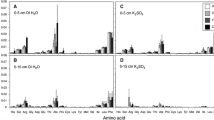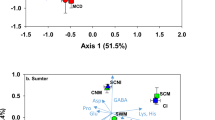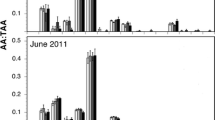Abstract
Amino acids have been shown to be a potentially significant N source for the alpine sedge, Kobresia myosuroides. We hypothesised that freeze-thaw and dry-rewet events allow this plant species increased access to amino acids by disrupting microbial cells, which decreases the size of competing microbial populations, but increases soil amino acid concentrations. To test this hypothesis, we characterized freeze-thaw and dry-rewet events in the field and simulated them in laboratory experiments on plant-soil microcosms. In one experiment, 15N,13C-[2]-glycine was added to microcosms that had previously been subjected to a freeze-thaw or dry-rewet event, and isotopic concentrations in the plant and microbial fractions were compared to non-stressed controls. Microbial biomass and uptake of the labeled glycine were unaffected by the freezing and drying treatments, but microbial uptake of 15N was lower in the two warmer treatments (dry-rewet and summer control) then in the two colder treatments (freeze-thaw and fall control). Plant uptake of glycine-15N was decreased by climatic disturbance, and uptake in plants that had been frozen appeared to be dependent on the severity of the freeze. The fact that intact glycine was absorbed by the plants was confirmed by near equal enrichment of plant tissues in 13C and 15N. Plants under optimal conditions recovered 3.5% of the added 15N and microbes recovered 5.0%. The majority of the 13C and 15N label remained in a non-extractable fraction in the bulk soil. To better understand the isolated influences of environmental perturbations on soil amino acid pools and population sizes of amino-acid utilizing microbes, separate experiments were performed in which soils, alone, were subjected to drying and rewetting or freezing and thawing. Potential respiration of glycine and glutamate (substrate-induced respiration; SIR) by the soil microbial communities was unaffected by a single freeze-thaw event. Glycine SIR was decreased slightly (∼10%) by the most extreme drying treatment, but glutamate SIR was not significantly affected. Freezing lowered the concentration of water-extractable amino acids while drying increased their concentration. We interpret the surprising former result as either a decrease in proteolytic activity in frozen soils relative to amino acid uptake, or a stimulation in microbial uptake by physical nutrient release from the soil. We conclude that climatic disturbance does not provide opportunities for increased amino acid uptake by K. myosuroides, but that this plant competes well for amino acid N under non-stressed conditions, especially when soils are warm. We also note that this alpine tundra microbial community's high resistance to freeze-thaw and dry-rewet events is novel and contrasts with studies in other ecosystems.
Similar content being viewed by others
Author information
Authors and Affiliations
Additional information
Received: 24 February 1997 / Accepted: 28 August 1997
Rights and permissions
About this article
Cite this article
Lipson, D., Monson, R. Plant-microbe competition for soil amino acids in the alpine tundra: effects of freeze-thaw and dry-rewet events. Oecologia 113, 406–414 (1998). https://doi.org/10.1007/s004420050393
Issue Date:
DOI: https://doi.org/10.1007/s004420050393




